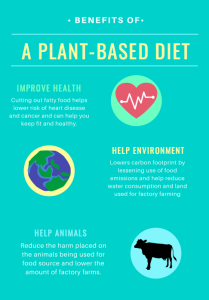We often hear about people ‘going vegan’ or eating an all plant-based diet, especially today, now that the trend has gone mainstream. While people advocate for plant-based diets and veganism because of all of the great effects it has, many people want to switch up their diet but struggle to break their current eating habits.
First, it is important to note that there are differences between a plant-based diet and veganism. People who eat a plant-based diet only cut out the food that comes from animal products such as eggs, dairy and meat. However, people who lead a vegan lifestyle avoid animal products in all aspects of life including clothes and cosmetics.
One of the main reasons that people tend to want to convert to a plant based diet is usually because of the animals. The animals used as a food source tend to be raised in very poor conditions on factory farms. Factory farms are an industrial facility that raises large numbers of farm animals in intensive confinement where they are overcrowded to the point of not being able to move freely and animals are typically kept in cages or crates, or are crowded together in pens.
Because of this, a lot of people decide to switch to a plant-based lifestyle or vegetarian or veganism because a lot of the meat that we eat is coming from these factory farms at the price of this poor treatment to the animals.
Another reason a lot of people are starting to switch is because of the environment. According to a study done by Joseph Poore, Department of Zoology at the University of Oxford in ScienceMag, animal products are one of the biggest contributors to the world’s carbon footprint.
“The impacts of animal products can markedly exceed those of vegetable substitutes to such a degree that meat, aquaculture, eggs, and dairy use 83% of the world’s farmland and contribute 56 to 58% of food’s different emissions, despite providing only 37% of our protein and 18% of our calories,” Poore said.
There is also the fact that the products used to feed and care for the animals such as grain, could be better spent feeding people directly.
In fact, a study from Cornell Chronicle states that with the amount of grain that the US feeds to its livestock, they could feed 800 million Americans.
“More than half the U.S. grain and nearly 40 percent of world grain is being fed to livestock rather than being consumed directly by humans,” David Pimentel, professor of ecology in Cornell University’s College of Agriculture and Life Sciences, said.
It is very beneficial to not only the environment, but your health, to switch to a plant based diet because it has been shown that it can help prevent diseases such as heart disease and type 2 diabetes and this is another reason as to why a lot of people want to jump onto the trend, but the problem is, they do not know where to start.
 Red meat, especially, generally has more saturated fat which can make your cholesterol and blood pressure rise, putting you at higher risk of heart disease.
Red meat, especially, generally has more saturated fat which can make your cholesterol and blood pressure rise, putting you at higher risk of heart disease.
A lot of people try to cut out meat and animal products all at once and decide that they’re done one day. While this may work for some people, most of us don’t have the willpower to quit cold turkey (literally).
Probably the best way to change your diet would be to slowly cut out meat and other animal products, meaning that you should try to eat less meat or maybe only two or three meals a week should have meat in it. The World Cancer Research Fund suggests to only limit your consumption of red meat to about three servings per week.
Try starting off with choosing one meal to be plant-based until you’re ready to increase, for example, make all of your breakfast meals plant-based so that your body can start to wean off of regular animal products.
Start substituting usual dairy products with plant-based alternatives, like replacing milk with almond or soy milk.
Another way to help you ease into the new lifestyle is pretty obvious, buy a lot of fruit, veggies and other healthy products and stop buying meat and dairy. The more you surround yourself with the food you are aiming to consume, the easier it will be to adjust to the lifestyle.
A lot of people view plant-based diets as not eating as much food, but this is not true. A plant-based diet is not about eating everything in moderation, it’s about eating as much as you normally do but eating healthier alternatives.
Switching to a plant-based diet is not only beneficial to your health by helping to prevent different diseases, it is also beneficial to the environment by reducing the percentage of food emissions as well as reducing the amount of farmland being used which is why so many people are trying to figure out how to successfully join the trend.


